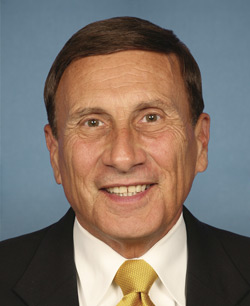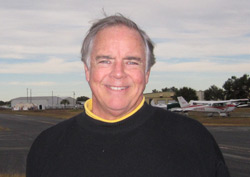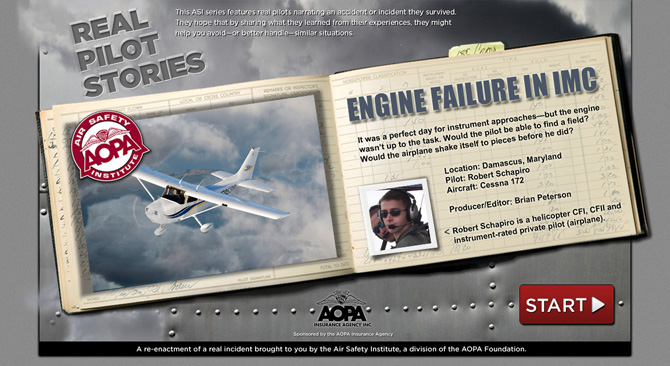AOPA Action
What AOPA is doing to keep you flying
KEEP 'EM FLYING
We’re fighting for you
Get in the air and fly, Fuller says
A severe recession. A dwindling pilot population. Numerous legislative threats. What can you do? Get in the air and fly.
That’s the message AOPA President Craig Fuller will be advocating throughout 2012. “The best action we can take to keep general aviation healthy is to get in the air and fly,” Fuller told attendees at the Northwest Aviation Conference and Trade Show recently. “Keep ’em flying” will be the theme for association initiatives throughout the year. It is based on activities of another time when GA faced tough times: People wanted to ground GA during World War II. “The Army Air Corps was struggling to recruit pilots,” Fuller said. “They came up with a great slogan that eventually turned into a hit song and even the title of a hit movie, Keep ’Em Flying. The idea is still relevant today.”
Fuller outlined numerous steps the association is taking to protect GA and help keep pilots in the air. First is growing the pilot population. AOPA’s study of the flight training industry, which took place in 2010, indicated that as many as 80 percent of those who start flight training do not complete it to earn a pilot certificate. In the study, key criteria emerged that play a role in student retention. AOPA is sharing that information with the flight training community “to help schools and instructors recognize what works and put that knowledge to use in their own businesses,” Fuller said.
A new program that will recognize flight schools and instructors who “do it right” has been launched. The AOPA Flight Training Excellence Awards, brought to you by Flight Training magazine, will be given annually to flight schools and individual flight training professionals. Nominations are being accepted (http:ft.aopa.org/awards) and will be viewed by a panel of judges assembled by the magazine. Winners of the award will be recognized at AOPA Summit in Palm Springs, California, this October. Those who nominate will receive an AOPA Flight Training Excellence Award challenge coin.
The MyFlightTraining website also has been launched. This site is specifically designed to help student pilots through the training process. Students can use the site to log milestones, receive customized information for their point in training, and ask questions of the experienced flight instructors in AOPA’s Pilot Information Center.
A second step in the Keep ’Em Flying initiative is getting pilots back into the air. In conjunction with EAA, AOPA is working to extend to all pilots the ability to fly 180-horsepower or less, single-engine, four-seat aircraft without a third class medical certificate. An estimated 56,000 aircraft would be eligible to be flown under the request. “Our proposal would give pilots who fly recreationally in certain types of aircraft the option of getting a third class medical or participating in recurrent online training that will teach pilots how to self-certify their fitness to fly,” Fuller said.
Another aspect of increasing the number of active pilots is getting those who have stopped flying back in the left seat. Last year, the association launched the AOPA Aircraft Partnership Program to match co-owners, making owning an aircraft a reasonable proposition for more pilots. So far, more than 10,000 participants have signed up for the program.
Step three is fighting for pilots in Washington, D.C. This means preventing the $100-per-flight user fee for turbine general aviation and commercial operations. “Our friends in Congress have repeatedly said the user fees are dead on arrival and we will work closely with them again to try to put a stop to this latest user fee plan,” Fuller said.
“These efforts will take time, but I believe they will make a difference with your help. When people choose to focus on the most successful and positive practices in any kind of endeavor, things improve,” said Fuller.
—Julie Summers Walker
Long-term FAA bill signed into law
For the first time since 2007, the FAA has the certainty of long-term authorization to operate the air traffic control system, build up airport infrastructure, and develop the air traffic control system of the future.
On February 14, President Barack Obama signed the conference committee report for the FAA Modernization and Reform Act of 2012. The bill provides a four-year, $63.4-billion authorization package for the agency, which has limped along on 23 short-term operating bills over the past five years.
The president’s signature—on a bill that is free of user fees or fuel-tax increases—had been awaited since House and Senate approval of the conference report just days earlier.
Conference committee members of both parties still sparred on the merits of individual provisions but agreed broadly that passage of a long-term authorization measure for the FAA was long overdue.
 Rep. John Mica (R-Fla.)
Rep. John Mica (R-Fla.)
“Today we have in place sound multiyear policies that reform FAA programs, eliminate expensive ticket subsidies, modernize our air traffic control system, improve airport infrastructure, reduce air traffic delays, and create jobs,” said Rep. John Mica (R-Fla.), chairman of the House Transportation and Infrastructure Committee, and the sponsor of the bill in the House.
“We appreciate the leadership of Chairman Mica in getting an FAA reauthorization measure through Congress,” said AOPA President Craig Fuller. “The FAA has worked for far too long with only short-term extensions that simply couldn’t provide the stability needed to support long-term projects like NextGen modernization.
“With the question of funding resolved through 2015, the FAA can focus on the real work ahead, from modernizing ATC to improving our airport infrastructure. At the same time, the GA community can focus on recovery and growth in an industry that creates jobs, links communities, and serves as an important economic engine.”
Mica noted that the new law contains reforms that “will provide the blueprint, metrics, benchmarks, and performance goals necessary for developing” the Next Generation Air Transportation System (NextGen).
“This critical effort to shift from our antiquated air traffic control technology to a GPS-based system will improve air traffic efficiency and safety, reduce fuel burn and pollution from aircraft, and bring costs down for consumers,” he said.
The bill authorizes $13.4 billion in Airport Improvement Program funding. It contains language on through-the-fence operations ensuring that general aviation airport sponsors not be considered in violation of federal grant assurances for entering an agreement with a property owner adjacent to the airport for airport access.
The bill also establishes a timeline for the issuance of improved, tamper-resistant pilot certificates that can accommodate a photograph, digital photograph, biometric identifier, or other unique identifier.
Other provisions include requiring the Transportation Security Administration to use qualified private screeners, working under federal supervision, and a veterans’ preference for small businesses owned by disabled veterans of the Afghanistan/Iraq conflict and the Persian Gulf war.
Congress must still approve annual appropriations to fund the FAA at the levels authorized in the bill signed by the president.
NATIONAL ACTION
FAA announces end of paper medical certificate applications
The good news is that medical certificate applications submitted online should be processed more efficiently, medical certification processing errors should be reduced, and taxpayers should get a break on federal spending. However, the transition away from paper applications for medical certificates presents AOPA with some concerns for pilots who don’t use computers, and the FAA is about to make it mandatory: As of October 1, aviation medical examiners will no longer accept paper applications.
The electronic medical certificate application system, introduced by the FAA in 2007, is relatively easy to use, and offers several benefits to computer-savvy pilots. Errors that once resulted from poor penmanship or transcription—errors that frequently resulted in delayed issuance of a medical certificate—should no longer happen. The electronic system should also make application processing more efficient, with less time spent by AMEs and FAA staff. This, in turn, will allow the FAA staff to focus its efforts on the more complex medical certification cases that require additional time for review.
The convenience of an online application comes with some risks, however, for pilots who do not have access to a wired Internet connection at their home or office. Using a public computer at a library, or a computer networked through a public wireless “hot spot” such as at a coffee shop or Internet café, could potentially compromise the security of medical information.
AOPA will launch an education effort to ensure pilots become familiar with the online application.
West Coast sanctuary overflight now a dangerous gamble
Pilots could face stiff fines—up to six figures—for violating new overflight regulations that place the National Airspace System on a slippery slope. The FAA has ceded to the National Oceanic and Atmospheric Administration authority to enforce new airspace restrictions.
AOPA supports the basic intent of “flying friendly” and compliance with FAA Advisory Circular 91-36D, “Visual Flight Rules Flight Near Noise Sensitive Areas,” the NOAA regulation would restrict overflights even further and impose consequences if a pilot does not comply. The rule is meant to protect wildlife in the Channel Islands, Monterey Bay, and Gulf of the Farallones national marine sanctuaries in California; and the Olympic Coast National Marine Sanctuary in Washington.
The regulation presumes that any pilot who flies below 1,000 feet msl in the vicinity of one of the protected sanctuaries (or below 2,000 feet msl in some areas) has disturbed the wildlife there. Penalties will be based on observations from the ground by personnel who may not have any aviation knowledge, training, or specialized equipment to make accurate calculations of an aircraft’s altitude.
Once NOAA advises that an operator has violated “their airspace,” pilots would be forced to prove wildlife was not disturbed to escape sanction.
Fines could range up to $100,000. However, NOAA action does not mean the FAA will take any certificate or enforcement action. The FAA did not oppose the move by NOAA to regulate overflights, and AOPA is concerned that other agencies will follow suit.
State and Local Action
$7,612
The amount in proposed luxury taxes that a new Cessna 182T owner would pay if Maryland's legislation is signed into law.
1. Maryland: Luxury tax targets ‘airplanes’
Aircraft sold for more than $35,000 are among targets of a new Maryland luxury tax proposal. AOPA is reaching out to legislators about Maryland House Bill 1345, which would add a 1-percent luxury surtax to the state sales and use tax on “motor vehicles, boats and airplanes” on sales amounts in excess of $35,000. The surtax on motor vehicles, boats, and airplanes sold for a taxable price of more than $90,000 would be $550 plus 2 percent of the amount in excess of $90,000. The bill would impose a luxury surtax on most retail sales of items valued more than $5,000. It was referred to the rules and executive nominations committee. Sponsors are Ways and Means Committee Chairman Sheila Hixson and Delegate Heather R. Mizeur. The bill’s introduction comes at a time when numerous other states have been acting to expand exemptions of aircraft from sales and use taxes as a way of bolstering the competitiveness of their aviation businesses, and of spurring employment.
2. Florida: Florida House passes aviation tax exemption
The Florida House has voted to expand a sales tax exemption to most light general aviation aircraft maintenance costs and the equipment used in the repairs. House Bill 7087, an economic development package backed by AOPA and the Florida Aviation Trades Association (FATA), passed the House by a margin of 92 to 22, with provisions making aircraft with a maximum certified takeoff weight of more than 2,000 pounds eligible for the tax exemption now afforded only to aircraft weighing more than 15,000 pounds (and rotary-wing aircraft weighing more than 10,000 pounds maximum certified takeoff weight). The legislation was introduced by Rep. Stephen L. Precourt (R-District 41), chairman of the Finance and Tax Committee, and moved directly to the full House, bypassing the committee referral process. The bill incorporated provisions of two bills supported by AOPA and FATA into the economic development measure approved by the House. Final passage would place Florida among a growing number of states with tax exemptions that are seen as boosting aircraft-repair businesses and employment in those states’’aviation industries. This legislation is another step toward creating jobs in Florida,”said Rep. Steve Crisafulli (R-Merritt Island), a co-sponsor. “For too long Florida has lost aircraft maintenance and repair business to other states because it hasn’t remained competitive in its tax policy. I am confident that this legislation will encourage aircraft owners to visit Florida’s world-class aviation maintenance and repair facilities.”We are very encouraged with the House passage of this significant legislation,” said Mark Kimberling, AOPA director of state government affairs. “We are now one step closer to finally extending the state sales tax exemption on maintenance to GA aircraft in the state. Lighter single and multiengine GA aircraft really are the heart of the aviation industry in Florida.“AOPA and FATA have already turned our attention to the Senate as we continue to work to get this important measure signed into law,””he said.
509
The total number of aviation maintenance, repair, and overhaul shops in the state of Florida. They employ more than 16,000 workers.
3. South Dakota: House passes homebuilder tax relief
The South Dakota House of Representatives has approved a bill—by a vote of 45 to 23—championed by AOPA and pilots across the state that will provide relief from double taxation of aircraft homebuilders. Working with the South Dakota Pilots Association, AOPA has called on lawmakers to enact tax policy that treats homebuilt aircraft the same as factory-built models. Under current law, both homebuilt and factory aircraft owners pay a 4-percent registration tax in lieu of a sales and use tax. Components such as engines, avionics, and propellers are exempt from additional taxation when installed in a factory-built aircraft, but state revenue officials recently began sending bills to homebuilders seeking back taxes on installed components. Pilots responded to a recent AOPA Action Alert urging them to contact state lawmakers and voice support for House Bill 1209, which now heads to the state Senate.
4. Indiana: Pro-GA bills clear Indiana House
Two AOPA-backed bills—one providing aviation sales-tax relief and the other establishing funding sources for airport ground-access maintenance—have won overwhelming passage in the Indiana House and are now before the Senate. House Bill 1325, providing a sales- and use-tax exemption for out-of-state aircraft flown into Indiana for “aircraft completion work,” passed 89 to 8. The measure is seen as boosting business prospects for the state’s 67 repair stations. The same day, House Bill 1307 passed 96 to 0. It would allow money from the state highway fund to be used for “construction, reconstruction, operation, and maintenance” of ground access points to Indiana’s airports. Both bills have been referred to the Senate Tax and Fiscal Policy Committee. Mark Kimberling, AOPA director of state government affairs, and Bryan Budds, AOPA’s Great Lakes regional manager, traveled to Indianapolis to urge support for the bills. “AOPA will remain engaged with key legislators as the bills are taken up by the Senate,” Kimberling said.
176
The number of state legislative GA issues AOPA is actively working on. It's a number that will continue to grow throughout the legislative year.
5. Washington: Bill could increase access to Washington state airports
Legislation that would offer clear liability
protection for private airfield owners in Washington state has cleared the state House and now heads to the Senate. AOPA is standing shoulder to shoulder with the Washington Pilots Association (WPA) and Recreational Aviation Foundation (RAF) in support of the measure, which would clarify existing law that protects private landowners from liability if they choose to make property available for public use. House Bill 2244 would amend the existing statute to clearly include private airfield owners, who are unsure the present law pertains to them. That uncertainty has prompted many private owners to deny public access to airfields. AOPA, the WPA, and RAF mobilized support from pilots for the measure, which has potential to increase the accessibility of a broad range of activities such as hiking, camping, and other outdoor recreation. AOPA contacted lawmakers and issued a call to action in January, mobilizing nearly 12,000 members in Washington state to voice their support. Bob Kay, the RAF Washington state liaison (and WPA member), helped spread the word, working closely with AOPA staff including Northwest Mountain Regional Manager David Ulane. The legislation passed the House with a unanimous vote, and is now under consideration by the Senate.
6. Idaho: House passes aviation tax exemption
The Idaho House of Representatives has unanimously passed a bill exempting aircraft parts, supplies, and other components from the state’s sales and use tax. The bill, strongly supported by AOPA and the general aviation community, is now working its way through the Senate. AOPA Northwest Mountain Regional Manager David Ulane has worked with members and local businesses for passage of the bill as a means of making Idaho’s FAA-approved aircraft repair businesses more competitive with repair shops in states that already provide a favorable tax environment.
Airport Support Network
Activist to ASN volunteer
 When Bob Gibson learned of AOPA’s Airport Support Network (ASN) program, he was already active in supporting his home airport in Clearwater, Florida. An AOPA lifetime member, Gibson saw serving as an ASN volunteer as the natural extension of his current activity at Clearwater Air Park (CLW).
When Bob Gibson learned of AOPA’s Airport Support Network (ASN) program, he was already active in supporting his home airport in Clearwater, Florida. An AOPA lifetime member, Gibson saw serving as an ASN volunteer as the natural extension of his current activity at Clearwater Air Park (CLW).
When the former volunteer retired, Gibson immediately stepped up and offered to take on the role. By the time he became Clearwater’s ASN volunteer, he had already been working with other pilots to form the Friends of Clearwater Air Park. Since then Gibson has helped establish the Clearwater Air Park Improvement Team with three other pilot activists. Together they have been actively engaged in working with the City of Clearwater on behalf of the airport. Over the past year, Clearwater has extended the daily operating hours for the airpark, which has brought additional business and tourism to the area. It has also agreed to improvements at the airport, including repairs to runway and taxi lights and surfaces, an agreement to extend the runway by 800 feet, and hangar improvements. With support from the Florida DOT plus city funds and the support of the aviation community, Clearwater faces a bright future.
Already making things happen at your airport? Why not work with AOPA and join our nationwide team of airport activists?
MEMBERSHIP PRODUCTS
Protecting flight instructors
Flight instructors are a valuable and critical resource to the future of GA. To help protect them, AOPA has a specialized insurance program especially for active CFIs. Whether a loss occurs at the time you are instructing in someone else’s aircraft or afterward, such as being named in a lawsuit for instruction previously given, AOPA can help protect instructors with a practical level of insurance coverage.
Multiple coverage options allow CFIs to best control the cost of policy premiums, as well as meet specific needs for the types of aircraft in which they are instructing. And most important, defense costs are in addition to any selected coverage limit; those often can be a much larger expense than the bent metal involved in an accident or incident.
Spend a few minutes visiting the website to review coverage options and obtain a quick quote, or simply call a helpful and knowledgeable member of the aviation insurance team in Wichita at 800-622-AOPA (2672) to discuss your needs and get answers to your questions.
Join AOPA at Sun ’n Fun 2012
Special admission discounts are being offered for AOPA members attending the thirty-eighth annual Sun ’n Fun Fly-In March 27 through April 1 in Lakeland, Florida. AOPA is once again the Platinum Sun ’n Fun sponsor and will offer many exciting activities around the show grounds throughout the week. Make your travel plans now. For show details, highlights, and ticket discount information see the website.
AIR SAFETY INSTITUTE
New Real Pilot Story
'Engine failure in IMC'

It was a good day to practice instrument approaches in actual instrument meteorological conditions. But, as pilot Robert Schapiro flew the missed approach at Montgomery County Airport in Gaithersburg, Maryland, his Cessna 172 began to shake horribly while the engine started losing power.
Engine Failure in IMC, the Air Safety Institute’s latest Real Pilot Story reenactment, beckons you to climb in the co-pilot’s seat to experience Schapiro’s harrowing search for a landing spot before his aircraft could shake itself to pieces.
You’ll hear Schapiro’s communications with ATC, and witness the difficult decision-making process that evolved during those precious moments to get the airplane on the ground safely.
Schapiro shares lessons learned about the significance of declaring an emergency and the importance of clear communication to get the help you need from ATC. A CFII in helicopters and an instrument-rated, fixed-wing private pilot, he hopes you’ll heed his advice should you ever encounter a similar emergency. Don’t wait; watch the video now.
VFR night flight, recommended

When you contemplate flying VFR at night, planning takes on another dimension—well beyond your usual VFR daytime flight planning. If not, it should. According to the Air Safety Institute’s accident database, the GA night VFR accident record shows proportionately more VFR accidents at night than during the day. This is not to scare you away from enjoying an exhilarating night flight—quite the opposite. But please be safe.
When ground lights are sparse, or the night is pitch-black without a brilliant moon, your flight can become more challenging than you expected. Conditions may even resemble IMC and it could be difficult to distinguish landmarks, terrain, and weather. This is a good time to carefully plan and review ASI’s Night VFR Flight Safety Spotlight, which offers plenty of night flying resources—all in one convenient place. Fully brief your flight and understand weather conditions that can produce marginal visibility, leading up to IMC levels. At night, marginal VMC should be considered a no-go for VFR operations.
Bolster your knowledge and fly prepared with ASI’s night VFR spotlight.
FREE AOPA ASF | |
|---|---|
|
April 09 | Madisonville, KY |
|
April 10 | Chesterfield, MO |
|
April 10 | Milan, IL |
|
April 10 | Morehead, KY |
|
April 11 | Springfield, MO |
|
April 12 | Warrensburg, MO |
|
April 16 | Concord, CA |
| April 16 | Pittsburgh, PA |
| April 16 | Salt Lake City, UT |
| April 17 | Fresno, CA |
| April 17 | New Cumberland, PA |
| April 17 | Pocatello, ID |
| April 17 | Woburn, MA |
| April 18 | Allentown, PA |
| April 18 | Boise, ID |
| April 18 | East Windsor, CT |
| April 18 | Palmdale, CA |
| April 18 | Timonium, MD |
| April 18 | West Lafayette, IN |
| April 19 | King of Prussia, PA |
| April 19 | Portsmouth, NH |
| April 23 | Blacksburg, VA |
| April 24 | Danville, VA |
| April 25 | Richmond, VA |
| April 26 | Hampton, VA |
| Tentative schedule, visit the Web site for more information. | |


